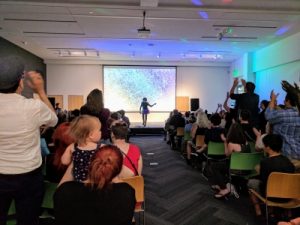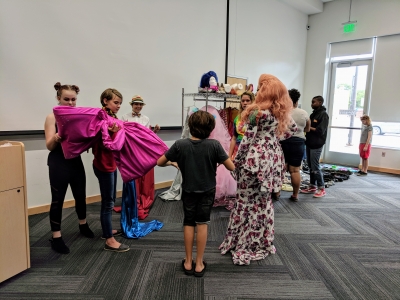
The following is an interview with TANVI RASTOGI, teen librarian at Ames (IA) Public LIbrary.
What is the title of your program?’
Camp Drag, All Ages Drag Show
Program or outreach description:
Camp Drag is a drag workshop for youth in grades K-12. The workshop was created to: provide interested young people with a unique opportunity that isn’t currently offered elsewhere in the community to learn the art of drag performance, including history, culture, and skills; provide youth with an age-appropriate venue in which to learn about and experience drag; allow youth to explore the diversity of drag performers and performance styles; help youth develop self-confidence and self-expression. The workshop was divided into four sessions. Sessions focused on the culture and history of drag; makeup; costuming; and the art of performance.
Camp Drag attendees were invited to use the skills they gained through the workshop and perform in an All Ages Drag Show that occurred two weeks after the conclusion of Camp Drag. The All Ages Drag show is an annual event that showcases performances by both professional drag performers and community members. It is divided into three separate parts: a show for attendees of all ages, followed by a Q&A during which teens can ask performers questions, followed by another drag show for teens-only (though this show still showcases professional adult drag performers).
Describe the planning and promotion you did to bring this program or outreach from an idea to reality.
I partnered with members of local organizations Ames Pride (of which I’m also a Board member) and Renegade Arts Collective to begin outlining how Camp Drag would be organized: which topics should be covered, how many sessions to host, program length, how to locate experts to serve as Camp instructors, and what information we should require from our potential instructors. Using this information, I created an instructor application (See Instructor Application). A Facebook event page was created to advertise the workshop to both potential instructors and attendees. We also sent the application directly to potential instructors we knew through previous work and asked them to pass it along to their own drag performer contacts.
For the All Ages Drag Show, I hire drag performers from around Iowa and the Midwest and keep a few slots open for community members (particularly youth) to also perform. Community members must register on our website or by speaking with me in advance of the show.
Who were your stakeholders and how did you create buy-in?
Primary stakeholders are GLBTQ+ community members, who receive the most benefit from these programs. Buy-in was created by working with GLBTQ+ individuals and organizations to create meaningful programs.
What was your program/event/outreach budget? Was funding a help or a hindrance?
I allocated $600 of Youth/Teen Services programming money for Camp Drag. This covered the cost of hiring instructors for $50 per session, as well as supplies like false eyelashes, disposable sponge applicators, eyeliner, eyeshadow, etc for the makeup session and masks, rhinestones, and feathers for the costuming session. A little over half of this budget was spent on the Camp.
All Ages Drag Show professional performers are paid $40 per performance. I typically hire 5 or 6 performers, most of whom perform twice (once in the all ages portion of the show and again in the teens-only show). I typically purchase generic-brand cookies for attendees and protein bars and water for performers (performing is hard work!). I also purchased five floor-length mirrors for performers to use–these were a one-time purchase for the library.
Funding isn’t entirely vital for these programs, but it helps. I believe many of our professional drag performers would volunteer their time and talent, but I prefer to pay them, just as the library pays performers for other library programs. Theirs is not an inexpensive art!
What was the biggest challenge you faced in putting your event together?
Many libraries face scrutiny when offering/highlighting GLBTQ+ programs, collections, and other resources, and ours has been no different. We’ve fielded phone calls, emails, and Facebook messages from both local community members and people outside of Ames expressing everything from concern that the library is not an appropriate venue to host such programs to outrage that library staff would expose children to “filth.” Camp Drag, in particular, received the most negative attention, and was the topic of several blog posts, podcasts, and radio shows. As expected, the Camp generated various threats: pickets, protests, having staff fired. We do develop safety plans for these programs but have not yet experienced any disruptions during our programs.
The positive side of negative feedback is that it encourages supportive community members to vocalize that support. The number of supportive letters, emails, phone calls, and messages we’ve received far outweighs the negative, and these can be used to demonstrate the importance of these programs to concerned Library Board members, staff, etc.
The largest challenge I personally faced was my own emotional response to the hateful language I heard being used in reference to these programs. Moving past those emotions was difficult but, like most things, it become easier with time to let those words roll off and keep working towards the goal of developing inclusive programming.
What’s next for you? Do you have anything new in the works?
Ames Public Library is one of the partner organizations presenting our community’s second annual Pridefest, which will be held in a few weeks on the streets outside the library. I’ve been helping with the subcommittee planning the programs that will occur throughout the day inside the library. Beyond that, our community is already clamoring for another All Ages Drag Show, and I will likely modify Camp Drag for next summer.
What advice do you have for those seeking to start GLBTQ+ programming/advocacy in their libraries?
Remember the following:
- While the wording may differ, most of our libraries mention developing collections/programs/resources for their “community.” Some even explicitly say they develop these for their “diverse community” or on “a wide variety of topics.” Check your mission/values statement, policies, and/or strategic plan for this type of wording, and use it to your advantage. When a library says it serves its community, that doesn’t mean it gets to decide which members of that community. All means all!
- Develop a rational, dispassionate response to critics within the community. Keep that response short and consistent. Make sure whatever you say can be backed up by your policies, etc. Here’s an example from APL:
“Thank you for sharing your opinion. We offer a wide array of programming that represents many diverse voices in our community. We offer hundreds of programs each year and realize that not every topic resonates with every community member. We hope that you and your family do find programs at APL that you enjoy. If you are interested in partnering with us to present a program, please feel free to submit a program proposal available on our website.”
- Short and consistent means there’s less room for your words to be twisted and used against you.
- If possible, don’t defend your program to critics. This can look like you’re pushing an “agenda.” Just note that this is just one of many programs you offer and that anyone is welcome to submit program ideas (if your library accepts these from community members).
- Work with community partners when possible. As someone who is not GLBTQ+-identifying, working with partners helps me ensure that program content is authentic, relevant, and respectful. Beyond that, it demonstrates to the community at large that: there is, in fact, an audience for your program (even in the unlikely event that that audience is just your partners); content is not being developed solely by library staff looking to push their “agenda.”
- Having community partners also means you have a built-in support network, so when the unhappy phone calls and emails start rolling in and negative attention builds, your partners’ contacts will likely counter that with support.
- Have your program goals written out thoughtfully and explicitly somewhere so they’re readily available to share with fellow library staff, Board members, etc. Keep a file of every email, letter, etc of support you receive (keep the bad ones, too). Your colleagues and bosses are those whose minds you might need to change.
- Educational programs are important, but also plan fun ones! These are more likely to attract a wide diversity of people and bring community members together, including people who maybe never would have expected to find themselves at something like a drag show (we’ve had many of these community members at ours!).
Anything else you’d like to share with readers?
The idea of “windows and mirrors” can and should extend beyond books and include programs, as well. A library drag show isn’t just a performance. It uplifts and affirms people. It gives GLBTQ+ families the opportunity to enjoy relevant programming together, across generations. It shows GLBTQ+ youth what’s possible for themselves, allows them to connect with others who share their experiences, and gives them a space to feel celebrated and supported. It demonstrates to the drag performers themselves that their art and they themselves aren’t something deviant or dangerous to be hidden away. A library drag show makes people feel seen–not only by their library, but also by the community that comes out to enjoy the show.
